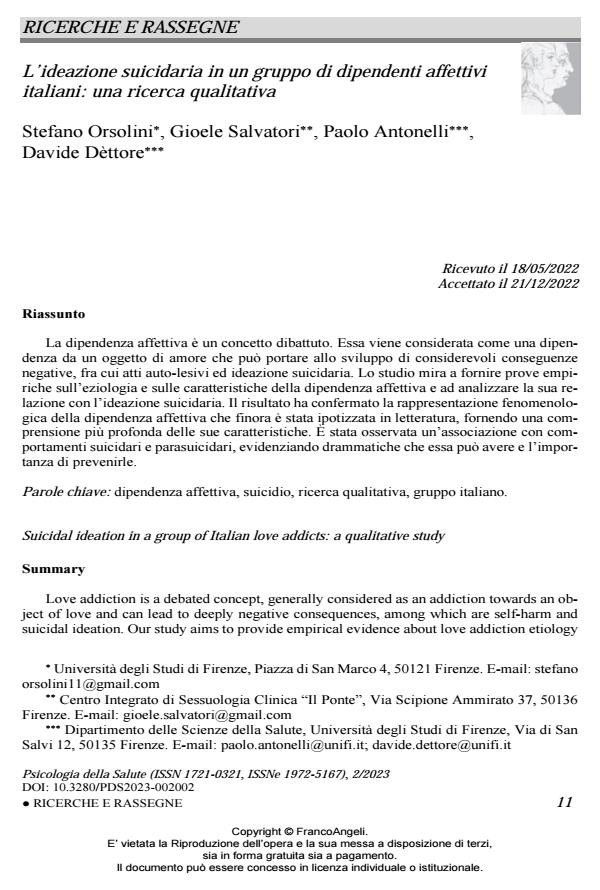L’ideazione suicidaria in un gruppo di dipendenti affettivi italiani: una ricerca qualitativa
Titolo Rivista PSICOLOGIA DELLA SALUTE
Autori/Curatori Stefano Orsolini, Gioele Salvatori, Paolo Antonelli, Davide Dèttore
Anno di pubblicazione 2023 Fascicolo 2023/2
Lingua Italiano Numero pagine 16 P. 11-26 Dimensione file 264 KB
DOI 10.3280/PDS2023-002002
Il DOI è il codice a barre della proprietà intellettuale: per saperne di più
clicca qui
Qui sotto puoi vedere in anteprima la prima pagina di questo articolo.
Se questo articolo ti interessa, lo puoi acquistare (e scaricare in formato pdf) seguendo le facili indicazioni per acquistare il download credit. Acquista Download Credits per scaricare questo Articolo in formato PDF

FrancoAngeli è membro della Publishers International Linking Association, Inc (PILA)associazione indipendente e non profit per facilitare (attraverso i servizi tecnologici implementati da CrossRef.org) l’accesso degli studiosi ai contenuti digitali nelle pubblicazioni professionali e scientifiche
La dipendenza affettiva è un concetto dibattuto. Essa viene considerata come una dipen-denza da un oggetto di amore che può portare allo sviluppo di considerevoli conseguenze ne-gative, fra cui atti auto-lesivi ed ideazione suicidaria. Lo studio mira a fornire prove empiriche sull’eziologia e sulle caratteristiche della dipendenza affettiva e ad analizzare la sua relazione con l’ideazione suicidaria. Il risultato ha confermato la rappresentazione fenomenologica della dipendenza affettiva che finora è stata ipotizzata in letteratura, fornendo una comprensione più profonda delle sue caratteristiche. È stata osservata un’associazione con comportamenti suici-dari e parasuicidari, evidenziando drammatiche che essa può avere e l’importanza di prevenirle.
Parole chiave:dipendenza affettiva, suicidio, ricerca qualitativa, gruppo italiano.
Stefano Orsolini, Gioele Salvatori, Paolo Antonelli, Davide Dèttore, L’ideazione suicidaria in un gruppo di dipendenti affettivi italiani: una ricerca qualitativa in "PSICOLOGIA DELLA SALUTE" 2/2023, pp 11-26, DOI: 10.3280/PDS2023-002002